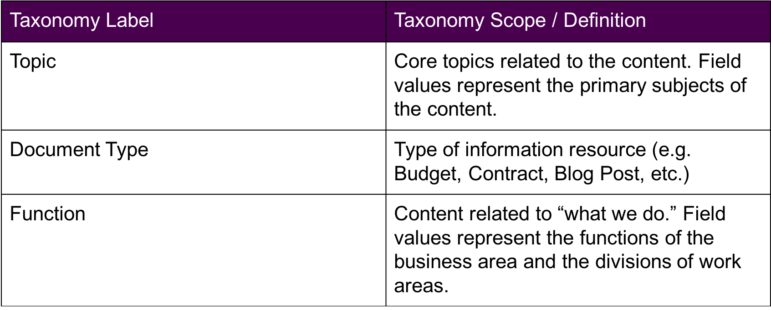Taxonomies are constantly evolving and growing alongside the businesses they serve. Users are not static and neither are their processes or the content they create and consume. Ensuring that the taxonomy grows holistically means keeping the entire vocabulary in mind when adding new terms or making changes to existing terms. This task can be especially challenging when there are multiple taxonomies involved within a certain content type.
In this blog I’ll talk about why new terms should be carefully considered and placed within the correct value list, reducing the occurrence of term overlap. I’ll also talk about how to do this when both the taxonomy and its governance plans are living, evolving entities.
We’ve seen this challenge within many client taxonomies. As a broad example, Jane, who works for an insurance agency, has written a new procedure about how to process a claim for a customer. We would tag it as “Claims ” from the Topic taxonomy, as a “Procedure” from the Document Type taxonomy, and as “Customer service” from the Function taxonomy. We would scroll through a list of values for each taxonomy and choose the term we thought fit best from each.
It sounds easy, but this only works when the taxonomy governance process ensures that each taxonomy value list remains mutually exclusive. Let’s look at a few steps that will help to guide taxonomy governance.
First, we begin by accurately and concisely defining the scope and parameters of a taxonomy, taxonomy values, or any kind of term before choosing a label. Defining the scope of a taxonomy is the first step towards taxonomy governance, as it provides guidelines for comparing and adding terms. Using our example above, we might define the three taxonomies as follows:
Second, we need to craft definitions for a new term before labeling and categorizing it within a taxonomy so that we can improve the quality of our controlled value lists. We can accomplish this by thinking about the reasons why a term has been suggested and by asking ourselves the following questions:
- Is there a new group of content being added to the repository?
- What pieces of content might be examples of what this term represents?
- Have we looked at the existing lists to make sure there is no overlap?
- Can we define a unique scope where this term will be applied?
If we don’t do this, our example above falls apart. We might notice that “Claims” is both a Topic and a Document Type. And even more confusing, “Claims” is listed as a Procedure. Now, instead of choosing tags that will help us to find Jane’s procedure from different paths, we have tagged it as “Claims” three times and effectively broken both the original design and the functionality of the business taxonomy.
So far, we’ve talked about two concrete steps we can follow to avoid the addition of duplicative or unnecessary terms to our taxonomy. However, it’s not enough to have these guidelines, we also need a team to own this process so it can be sustainable and user-centric without ‘breaking’ the original design. The governance team can drive the evolution of the taxonomy by doing the following:
By following these steps to define your governance model, you will achieve a sustainable taxonomy design that is capable of continuous evolution.
Do you need help or want to learn more about implementing or refreshing a taxonomy governance plan? Contact us at info@enterprise-knowledge.com


